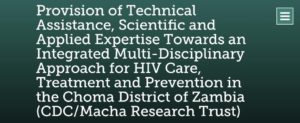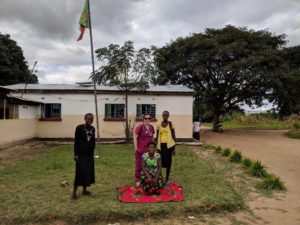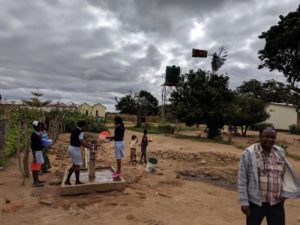HIV Clinic in the remote villages
April 15th, 2018 by jamiefelzer
Friday reminded me of why I went into public health and medicine, and seemed to connect the puzzle pieces of my life choices. One of the many reasons why I went into public health was my experience in Dance Marathon (DM), where we focused on HIV awareness and education, and our main beneficiary was the Elizabeth Glaser Pediatric AIDS Foundation (EGPAF). Through my involvement on the Operations Committee and DM as a whole, I realized I loved where medicine intersected with the public in education and programs. Both in college and medical school, my love for making medicine available to a wider community of people came to fruition when I had the opportunities to go to Peru and Ecuador. It was full circle going to the village working with the ART clinic because it seemed like all my life choices were coming together in one point. The doctor running the ART clinic in the villages was working in the pediatric department and we started talking a lot about the prevalence and incidence of HIV in the area and how treatment was affected by various programs. I then mentioned about EGPAF, not really sure what to expect when he answered, but was certainly surprised to hear that there was a multi-disciplinary partnership with CDC/PEPFAR/EGPAF for management of HIV-associated care with Macha Research Trust for 5 years. Right there I felt that all my life decisions including Dance Marathon and its affiliation with EGPAF, working at CDC, and now coming to Macha hospital and the research trust were connecting and making sense. Coincidence? I think not. I think it was a sign that all these decisions I labored over throughout the years had happened for a reason.

The ride to this rural village of Mobola took at least 2 hours, even though it was only 40km because of the poor condition of their “roads”. There were only a few miles of paved road, the rest was a dirt road that was ravished by bad rain storms and hadn’t been leveled in years. Bumpy is a light term to describe these roads. We had to keep switching sides of the road based on what the best path was at the current time. Luckily, there weren’t too many other cars that we had to pass as we were weaving all over. Often, the smoothest part of the road was on the edge, so we were tipped over, sometimes at a pretty steep angle. There were certain times when we slowed down to only go a few miles an hour because there were massive pot-holes and as I looked around in the van, where I was knocking knees with 7 grown men in the back, we looked like bobble heads on steroids. I told my Zambian colleagues that people at home only do this for fun in an off-roading vehicle. The crazy part was that I could even show them pictures of my brother off-roading in his truck on Instagram in the middle of Zambia. How far technology has come! By the time we reached our destination, my legs and knees, as well as my tush were all hurting. We had brought all the meds and other supplies, including the patients’ charts with us, so we unpacked everything from the roof of the truck prior to starting clinic.

Loading up the van with all the supplies
We set up shop in the clinic, which normally functions as a general clinic that is run by community health workers and nurses. There are generally no clinical officers (similar to a PA/NP) or medical officers (MD equivalent) so there were a couple of sick patients that the CHW came in to ask us to see. The biggest limitation was the lack of medication, especially when trying to treat a pregnant, HIV+ lady with foul-smelling discharge and pain with urination. We had to empirically treat her for a UTI/GC/Chlamydia/candidiasis because we had no culture data and those items were high on our clinical suspicion based on the examination. However, we only had mostly oral agents, some of which were not advised in pregnancy so we had to keep altering our choices based on what was available and safe in pregnancy. So glad I brought my pocket Pharmacopedia and Sanford with me to help in these situations!

In front of the clinic where some local ladies were posing for a picture and wanted me to join
The kids and their parents filtered in and we checked to see how they were tolerating their meds, if they were having any side effects or other illnesses, and on their medication compliance. Each child had to be weighed prior to seeing us, as their meds were dosed based on weight, and medication regimes were altered after a certain age. Most of the children were doing well and just had to get medication refills, most of which would return in 3 months. If changes were made, they were asked to come back in 1 month. CD4 counts were generally checked every 6 months and viral loads every year (which take 3 months to sometimes come back). For the most part, people seemed to be doing well with their treatments. One case that struck me was a 12 year old boy who appeared no older than 8, whose mother had died shortly before the time of his diagnosis with pulmonary TB and HIV at age 8. He was successfully treated with anti-tuberculous medications using DOTS (directly observed treatment) and then initiated on ART. He also unfortunately suffered from ringworm on his head that was complicated by a superimposed bacterial infection, which now left him with huge scars on his head. All of his illnesses have clearly stunted his growth, and he is doing much better now and cared for by his aunt, but it just breaks your heart that this kid at 12, has gone through more than hopefully most of us have to deal with in our lives.
In the room where I sat they also had their refrigerator for the vaccinations, and charts of their vaccine coverage. Again, the public health nerd in me was very excited by this data that they had collected and that was displayed. Some of the staff were doing blood draws for those who were due (and we brought all the samples back to Macha to be run), but there were having a difficult time with some of the draws and needed a doctor to help. Ironic because I haven’t drawn blood in quite some time. Nonetheless, the first was a 4 year old boy who I had to draw blood with via an 18-gauge needle (very large) plugged directly into the vacutainer (so there was no flash indicating when I was in the blood vessel). Every time I got near him he flinched, making things even more difficult, but I was successful. Instead of alcohol, they soak a large container of cotton swabs in purple-colored spirits to clean the site. The even trickier one was a 10-month old who I had to do a femoral stick. I found my landmarks and as I was trying to get blood she starting peeing like a fire hydrant as she wasn’t wearing a diaper which of course made me pause for a moment and try not to contaminate my field. I was glad when that one was over successfully.

The water pump outside the hospital
Today was a crazy day at the hospital! We first rounded on the men’s wards which wasn’t all that out of the ordinary with some sick HIV patients who we didn’t really know what was going on based on our limited testing capabilities. Then I went over to women’s ward, which was sadly like one big TB ward. So glad I brought plenty of N95s! There are only a few places where they have power to give oxygen and they had moved one lady from the veranda (true TB area) because she needed oxygen and was more somnolent. She was HIV+ and hadn’t been eating for weeks. Next to her was a 44-year-old lady the doc called Asthma exacerbation because she had chest pain and shortness of breath but when I looked at her she was very sweaty and breathing fast. I thought she might’ve had an MI, PE or been septic but there was no data, nor any interventions should she have most of those items, so she was treated with some steroids and inhalers. Sadly, by the time we finished rounding we were casually called to her bed because she had stopped breathing and was pulseless. We gave her adrenaline and did some chest compressions, but there was sadly nothing more we could do for her. Even if we had to had been able to resuscitate her, we didn’t have advanced life support or even an EKG machine to see the type of rhythm she was in. It felt terrible not being able to do anything more for this poor lady, leaving her husband alone with their kids and newborn. Unfortunately, death is a common thing here as the infant mortality rate is quite high.
Another lady who was HIV+ and previously had TB had an entire lung that was whited-out, which made us concerned for multi-drug resistant TB. We sent off a gene test for resistance patterns of TB but started her on the regular treatment for TB as we didn’t have any more advanced medications. There was also a 24-year old girl with HIV who had a terrible nose bleed and GI bleed with a Hgb of 2.8!!!! (normal is at least 13 in a female, in the US we transfuse at 7, they transfuse at 5 or 6 because so many people are anemic). Her platelet count was also very low, as were her WBCs. With our limited testing capabilities and limited products we weren’t left with many options except to re-check her counts and try stopping her bleeding best we could with packing, treating for parasites and giving Vitamin K.
My success story of the day was an HIV+ lady that came into clinic virtually unconscious 2 days prior. I did successfully resuscitate her as a septic patient, and was so happy to see her sitting up in bed smiling without any further episodes of fever and only mild hypotension. After 5 hours of rounding on these terribly sick patients where I felt helpless with the limited options, I was exhausted and ready to get some hearty food at Ester’s.


Sorry, comments for this entry are closed at this time.